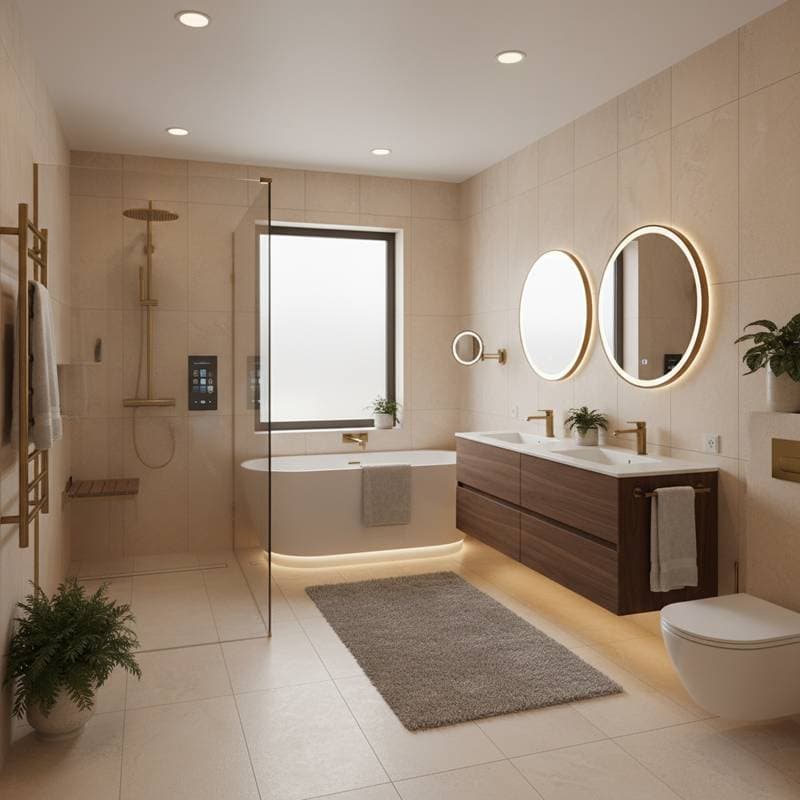4. Touchless Lighting and Ventilation
Motion-activated lighting enhances hygiene and comfort by eliminating the need to touch switches, particularly in low-light conditions. These systems activate automatically upon detecting movement, providing illumination without direct contact. Pair this feature with a humidity-sensing exhaust fan that turns on when moisture levels rise, ensuring proper ventilation to prevent mold growth and maintain air quality.
Cost range: $40 to $150 for lighting sensors; $100 to $300 for humidity-sensing fans.
Installation tip: When replacing an existing fixture, verify that wiring is already in place to simplify the process. Consult the manufacturer's instructions for compatibility with your current setup.
Practical Considerations Before Installation
Budget and Value
Touchless technology spans various price points to suit different needs. For a budget-friendly do-it-yourself upgrade, allocate $200 to $400 for items such as a sensor faucet, soap dispenser, and light sensor. A mid-range remodel incorporating a smart toilet or integrated ventilation system typically ranges from $800 to $1,500. Premium smart bathroom setups with coordinated fixtures and voice control often exceed $3,000, influenced by brand selections and design preferences.
The investment yields returns through improved hygiene and reduced water consumption. Touchless faucets can decrease water usage by up to 30 percent, potentially conserving thousands of gallons annually for an average household. Over time, these savings accumulate, offsetting initial costs while promoting environmental responsibility.
Maintenance and Reliability
Touchless fixtures require regular upkeep to function optimally, including sensor cleaning and battery replacements as needed. Use a soft cloth and mild soap to wipe sensors weekly, preventing mineral buildup that could impair performance. For hardwired systems, inspect connections once a year to confirm secure and efficient operation.
In the event of a sensor malfunction, refer to the manufacturer's troubleshooting guides, which provide step-by-step solutions. Steer clear of harsh cleaners, as they may damage the sensor lens or protective finishes like chrome. Consistent maintenance extends the lifespan of these devices and ensures reliable daily use.
Power Options
Battery-powered units offer the simplest installation, though they necessitate periodic battery replacements to avoid interruptions. Hardwired models provide a consistent power source without battery waste but may involve higher upfront installation expenses. Hybrid fixtures equipped with rechargeable lithium batteries that connect to a standard outlet present a balanced option, combining ease of setup with reduced maintenance demands.
Evaluate your bathroom's electrical layout when selecting power options. Battery units suit renters or those avoiding structural changes, while hardwired systems appeal to homeowners seeking long-term durability.
Safety and Compliance
Electrical touchless fixtures must adhere to local building codes for safe operation. Install them with ground fault circuit interrupter (GFCI) outlets in moisture-prone areas to protect against shocks. Engage a licensed electrician if uncertainties arise regarding connections or compliance.
For plumbing-related installations, contact your local building department to determine permit requirements. Major remodels or alterations to water lines and electrical circuits often necessitate approvals to ensure structural integrity and safety standards.
Adapting the Look to Your Bathroom
Touchless technology integrates seamlessly without compromising aesthetic appeal. Fixtures are available in finishes like brushed nickel, matte black, and polished chrome, allowing coordination with traditional or contemporary bathroom themes.
In compact spaces, opt for wall-mounted faucets and streamlined smart toilets to maximize floor area while preserving a modern profile. Brands also provide touchless options in classic forms and materials, enabling subtle enhancements that align with existing decor.
Consider scale and placement during selection. Test samples in your lighting conditions to confirm visual harmony before finalizing purchases.
Steps to Implement Your Upgrade
Begin the process with modest changes, such as installing a touchless faucet and soap dispenser, to assess integration into your routine. Observe how these elements improve convenience and hygiene over a few weeks.
Progress to additional features like lighting sensors or a smart toilet for a comprehensive transformation. Plan the entire system thoughtfully, aligning finishes, power sources, and positions for cohesive functionality.
Touchless fixtures have evolved from commercial novelties to essential home improvements. They deliver cleanliness, ease, and resource efficiency, fostering bathrooms that enhance well-being and reflect contemporary living standards.










